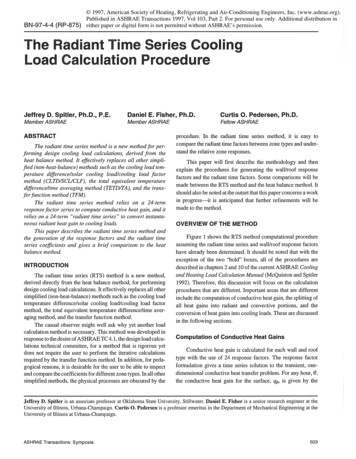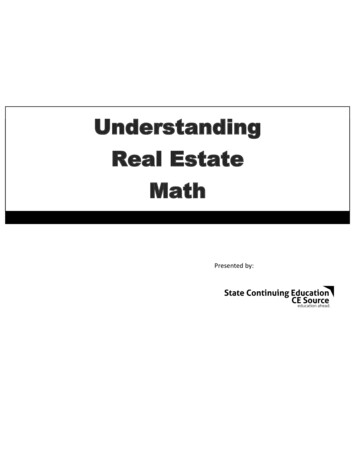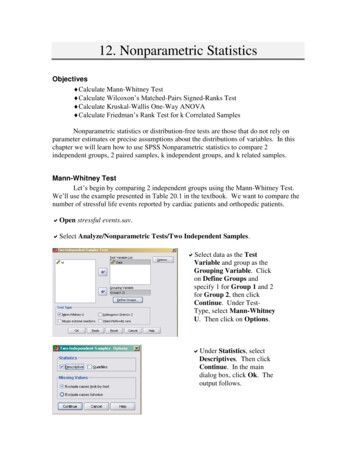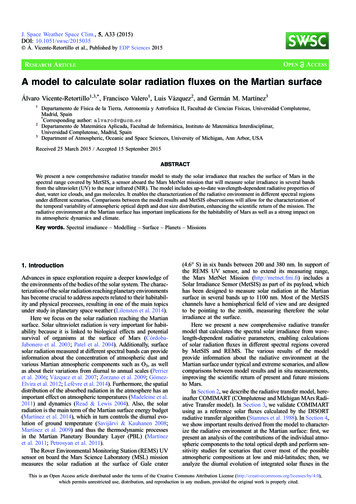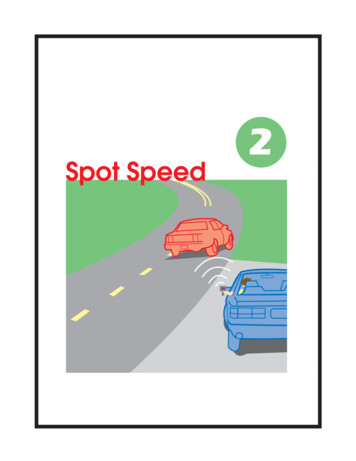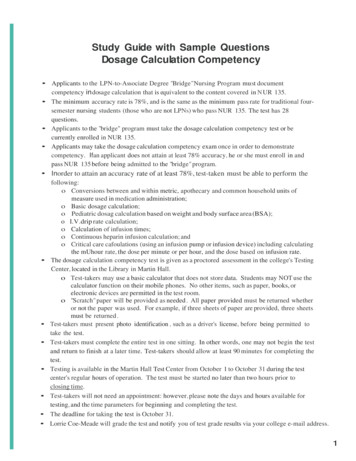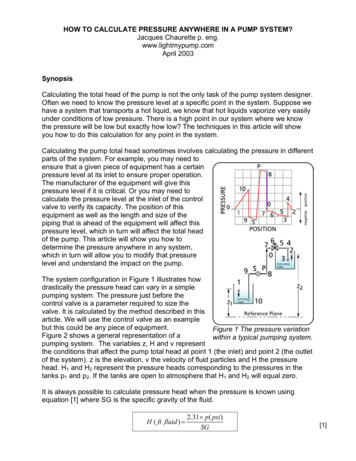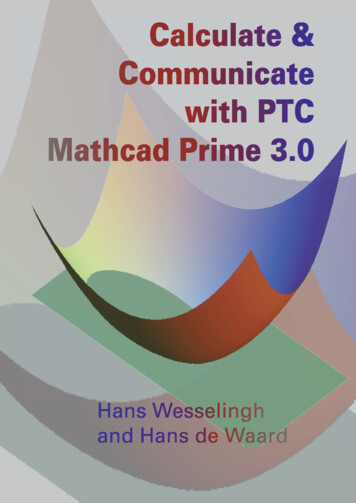
Transcription
Calculate & Communicatewith PTC Mathcad Prime 3.0J.A. WesselinghEmeritus, Department of Chemical Engineering,University of GroningenH. de WaardTechnical Research and Development,Novartis Pharma AG, BaselDelft Academic Press
Mathcad is owned by Parametric Technology ft Academic Press / VSSDFirst edition 2014Published by Delft Academic Press / VSSDLeeghwaterstraat 32, 2628 CA Delft, The Netherlandstel. 31 15 27 82124, e-mail: hlf@vssd.nlPublishers website: http://www.vssd.nl/hlfAbout this book: www.vssd.nl/hlf/a037.htmAbout Mathcad: www.ptc.com/product/mathcad/All rights reserved. No part of this publication may be reproduced, stored in aretrieval system, or transmitted, in any form or by any means, electronic,mechanical, photocopying, recording, or otherwise, without the prior writtenpermission of the publisher.Printed version:ISBN 978-90-6562-355-3Electronic version:ISBN 978-90-6562-356-0NUR 918, 991Key words: MathCad
InstructionsThis book accompanies the do-it-yourself course Calculate & Communicate with PTC Mathcad Prime 3.0. In this course you will learn to uselarge parts of applied mathematics on a computer. You will also learn towrite up your calculations in such a way that others will be able to followand use what you are doing.Course InstructionsThe course consists of 25 interactive lessons, each accompanied by at leastone computer exercise. You must download these from the PTC website.The lesson files are read-only, so you can practice without really changingthem. (You can save your own files under a different name.) Each lesson,with exercises, should take between a half and a whole hour. The lessonwill give you an idea of what can be done - you will need more time topractice using it on real problems. Files with answers to the exercises areavailable, but we advise you not to look at these before you have tried theexercises yourself.There are five parts. The first two, comprising 12 lessons, should be usefulfor everybody using Mathcad Prime 3.0 or its free sibling MathcadExpresse 3.0. The last three parts (13 lessons) are meant for those whoalready know calculus. Most of these lessons required the full Prime 3.0.To begin, open the lesson '1 Introducing Mathcad' in PTC MathcadPrime 3.0 and work through it. The lessons closely follow those in thisbook, but you will be using the live program on screen.What is New?If you are working with earlier versions 15 or earlier of Mathcad, you arein for some re-learning. Mathcad Prime is not 'just an upgrade'. The wholeprogram has been revamped - the interface, but also the content and wayof working. Your cunning workarounds for program inconsistencies mayno longer work (what a disappointment); but then you may no longer needthem (what a relief!). You will have to get used to new ways of editing but will find that these are easier to understand and remember. It takes alittle time to find your way in the interface with ribbons, but once youhave done that, you will never want to go back. We suggest that you atleast try lesson 1 (the interface), 6 (editing of equations), 7 (2D plots), 9(3D plots), 10 (labels and units), 17 (Excel) and 21 (vectors and matrices).The changes are the largest in these subjects.For users of Mathcad Prime 1.0 or 2.0 the changes are less important. Thebig ones are in lesson 6 (editing of equations), but you will find manysmaller changes in lesson 1 (the interface), lesson 3 (templates) and lesson7 (labels and global variables). We have partly rewritten lessons 11 and 12on programming, and lessons 13 through 16 on statistics.
Table of ContentsPart 1 - Basics1 Introducing Mathcad2 Handling of Text3 Worksheet Layout4 Mathcad as Calculator5 Variables and Functions6 Editing of EquationsPart 2 - Further7 Ranges and Plots8 2D Plots of Functions9 3D Plots of Functions10 Labels and Units11 Programming - Branches12 Programming - LoopsPart 3 - Applied13 Statistics14 Distributions15 Testing16 Data Analysis17 Input / OutputPart 4 - Symbolic18 Symbolic Calculus19 Solve and Series20 Shaping Equations21 Vectors and MatricesPart 5 - Numerical22 Linear Equations23 Non-linear Equations24 Solving with Functions25 Differential Equations26 33141143151161167175185187197203209219221
Part 1BasicsIntroducing MathcadHandling of TextWorksheet LayoutMathcad as CalculatorVariables and FunctionsEditing of Equations
1 Introducing MathcadIn this course, you will learn to use mathematics with PTC MathcadPrime 3.0. Why Mathcad? There are several reasons:1. It handles all mathematical tasks under a single interface.2. These are in standard symbolic or numerical notation.3. Calculations can be embedded in text, with plots and illustrations.4. The calculations are live, as in a spreadsheet. So they are easilymodified and corrected.5. The results are readable by any scientist or engineer (not onlyMathcad users). So they can be used to communicate with others.Mathcad is very useful for problems where you need to be flexible andcreative: when you are learning a subject, doing homework, designing, ordeveloping a new product or theory. You can even write a book in it, asthis text shows.If you do not know Mathcad, you will need to spend some time learningthe program. The interface is intuitive, but there are lots of details to bemastered. This set of Mathcad files should help you. It consists of lessonson the following subjects:Basics1 Introducing Mathcad2 Handling of Text3 Worksheet Layout4 Mathcad as Calculator5 Variables and Functions6 Editing of EquationsFurther7 Ranges and Plots8 2D Plots of Functions9 3D Plots of Functions10 Labels and Units11 Programming - Branches12 Programming - LoopsApplied13 Statistics14 Distributions15 Testing16 Data Analysis17 Input / OutputSymbolic18 Symbolic Calculus19 Solve and Series20 Shaping Equations21 Vectors and Matrices(this lesson)continued on the next page
8 2D Plots of FunctionsIn this lesson we explore the many variations in plots. We use the sameterms as in lesson 7. Check that you have the names of the plot elementsin your mind.Trace TypesTo change the type of a trace, activate its y-legend, then choose from Plots Traces Change Type. Below are images using the first four types.line tracestem tracecolumn tracebar traceThere are more trace types in the list: we will use some of them further on.If you are reading this file on screen, switch to Draft view and try thedifferent types in the plot on the right. (With the bar trace you need toexchange the axes to get the figure above.) While you are doing this, alsolook at the effect of changing both type and trace thickness.Multiple TracesTo add a trace to a plot, select the y-legend in the plot and apply Plots Traces Add Trace. A new y-legend will appear. You can add more legends. You can also add x-legends, but we will not do so here.
Calculate & Communicate with PTC Mathcad Prime 3.018-7 Fractal Lung30 minThis file considers a model of the lungs, of which you see an image below.from Wikipedia,by RastrojoYou see a large air tube (the trachea) splitting into finer and finer tubes(the bronchi and bronchioli) and ending in clusters of alveoli. The alveoliprovide the huge area required for exchange of oxygen and carbon dioxidebetween the body and the atmosphere. We will model the tubes using a'fractal' structure.Fractal StructureIn this structure the initial tube splits in two, the following also splits andso down to smaller and smaller levels. The word 'fractal' implies that theshape remains the same at each level - here that the length over diameterratio is the same for all tubes. Nature often seems to emulate fractalstructures - and they can have simple mathematical properties.158
21 Vectors and MatricesYou may know a lot about this subject without having realised. A columnin an Excel spreadsheet is a column vector. A row of figures is a rowvector. A block of figures is a matrix. These are arrays of numbers. Calculations in Excel are vector and matrix operations. You can do these inMathcad with the advantage that calculations are much easier to follow.Introduction 1So far our vectors have always started with element '0'. In this lesson it issimpler to let them start at '1'. You do this with Calculation WorksheetSettings Origin. We always put this change in the heading of aworksheet - it can be confusing if you forget. Now look at a few matrices: 1 2 3 4 ( )( ) ((θ)) cos (θ) sin (θ) sin ((θ)) cos ((θ)) a b c d As you see, they may contain numbers ('scalars'), symbols or evenfunctions. They may also contain elements of text ('strings'), but we willnot use these. We have given all matrix names the system label: this givesthe bold upright letters used in math texts. The elements of a matrix canbe output using subscripts:2,2 41,2 π ― 6 b1,1‾‾3 ――2The matrices above are 2u2 squares, but arrays can have any dimensionsas long as they are rectangular:[[ 3 ]] 1u1 array: an ordinary number 1 2 3u1 array: a column vector 3 3u3 matrix 1 7 13 3 2 6 4 11 0 q s u w p r t v [[ 4 5 6 ]]1u3 array: a row vector4u2 matrixremember:rows first, columns secondAlso here the elements are extractedusing subscripts:For column vectors you can omit thesecond subscript, but not for row vectors.2,1 22 21,3 63,2 11v ?2 1 3 4 1⟨⟨⟨1⟩⟩⟩Under Math Operators and Symbols Operators Vector and Matrixyou will find commands for extracting columns and rows: [[ 1 7 13 ]]
for everybody using Mathcad Prime 3.0 or its free sibling Mathcad Expresse 3.0. The last three parts (13 lessons) are meant for those who already know calculus. Most of these lessons required the full Prime 3.0. To begin, open the lesson '1 Introducing Mathcad' in PTC Mathcad Prime 3.0 and
